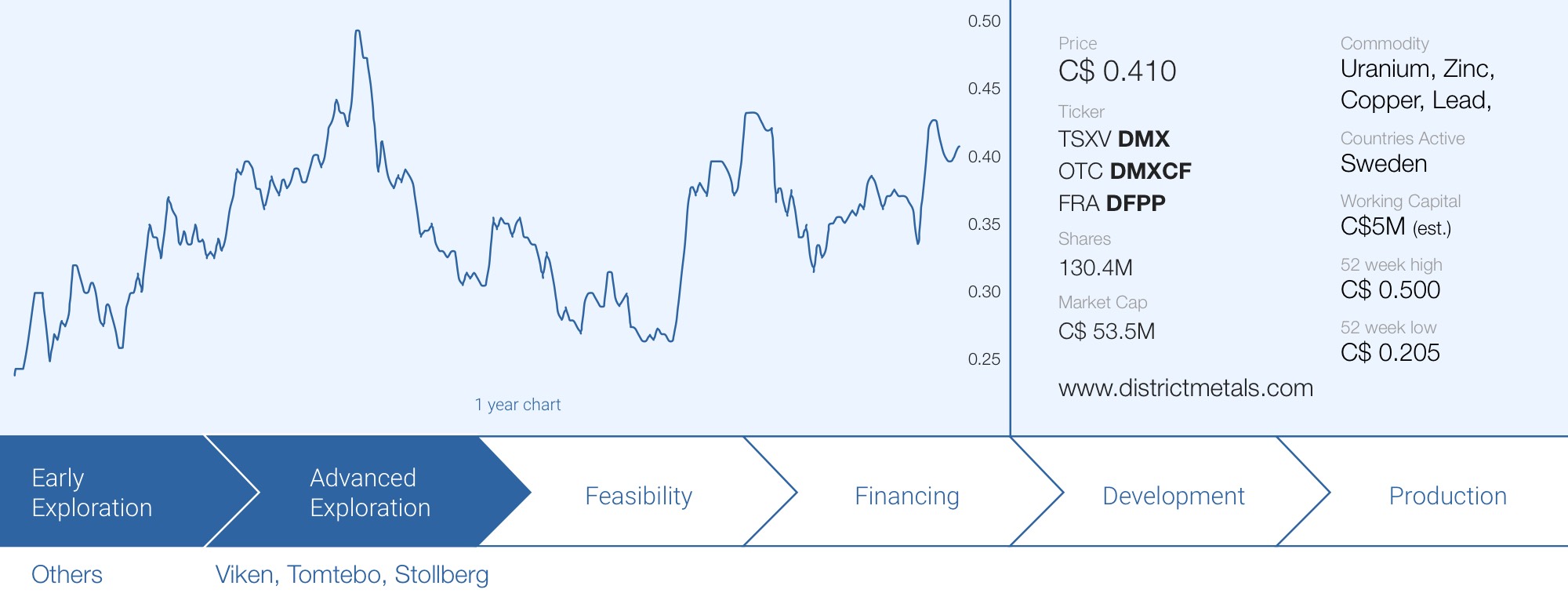
All eyes are obviously still on Sweden where the company owns 100% of the Viken deposit, a large undeveloped alum shale project with an average grade of just under 0.02% U3O8 and 0.3% V2O5 (vanadium pentoxide). While vanadium is the dominant contributor to the in-situ rock value per tonne, the importance of uranium is undeniable. The Viken project hasn’t gone anywhere in the past due to the moratorium on uranium mining and processing in Sweden but in the past eighteen months, some important pieces started to move and for the very first time, there now is a clear timeline towards lifting the ban on uranium-related activities in Sweden.
And just yesterday, the company announced it repurchased a 2% NSR over the remaining four deposits that are part of the Viken project, by issuing 500,000 shares of District Metals.
We sat down with CEO Garrett Ainsworth to discuss the most recent developments in Sweden and the plans forward for the company.
Uranium in Sweden
In your recent update published just before Christmas you briefly commented on the press release issued by the Swedish Ministry of Climate and Enterprise, releasing the results of the enquiry into lifting the uranium moratorium. An important press release that was long overdue as the initial inquiry started in February 2024.
The press release of the Swedish government is encouraging as it reiterates its plan to remove the ban on uranium mining. Can you elaborate on the details of the announcement and what this means for District Metals?
The Swedish Government’s release of the inquiry into lifting the uranium moratorium and their supporting press release on December 20, 2024 were highly anticipated, and the results are all very positive. Two key outcomes from this inquiry include: 1) the existing ban on uranium mining in the Environmental Code will be lifted, allowing uranium mining in Sweden, and 2) uranium will be classified as a concession mineral under the Swedish Minerals Act.
We’ve been hearing that these would be the likely outcomes of the inquiry throughout 2024, but now there is also a timeline on how the Swedish Government intends to lift the uranium ban that includes:
- A written consultation on the inquiry will take place until March 20, 2025.
- A legislative proposal will be presented to Parliament following March 20, 2025.
- The proposed legislative changes are set to take effect by January 1, 2026.
Strong statements were also made by each of the Liberal, Christian Democrats, Sweden Democrats, and Moderate political parties in support of lifting the uranium ban.
The details of the inquiry and their supporting press release are very positive for District Metals as it is crystal clear that the Swedish Government intends to lift the uranium ban, which makes the risk-reward profile for our Swedish uranium polymetallic properties look much better.Given this proposed timeline to lift the uranium ban we now have confidence in the government’s process to fly some airborne geophysical surveys on our Swedish uranium polymetallic properties. We are still in the planning phase of this proposed exploration work, so expect more detailed news about this in H1 2025.
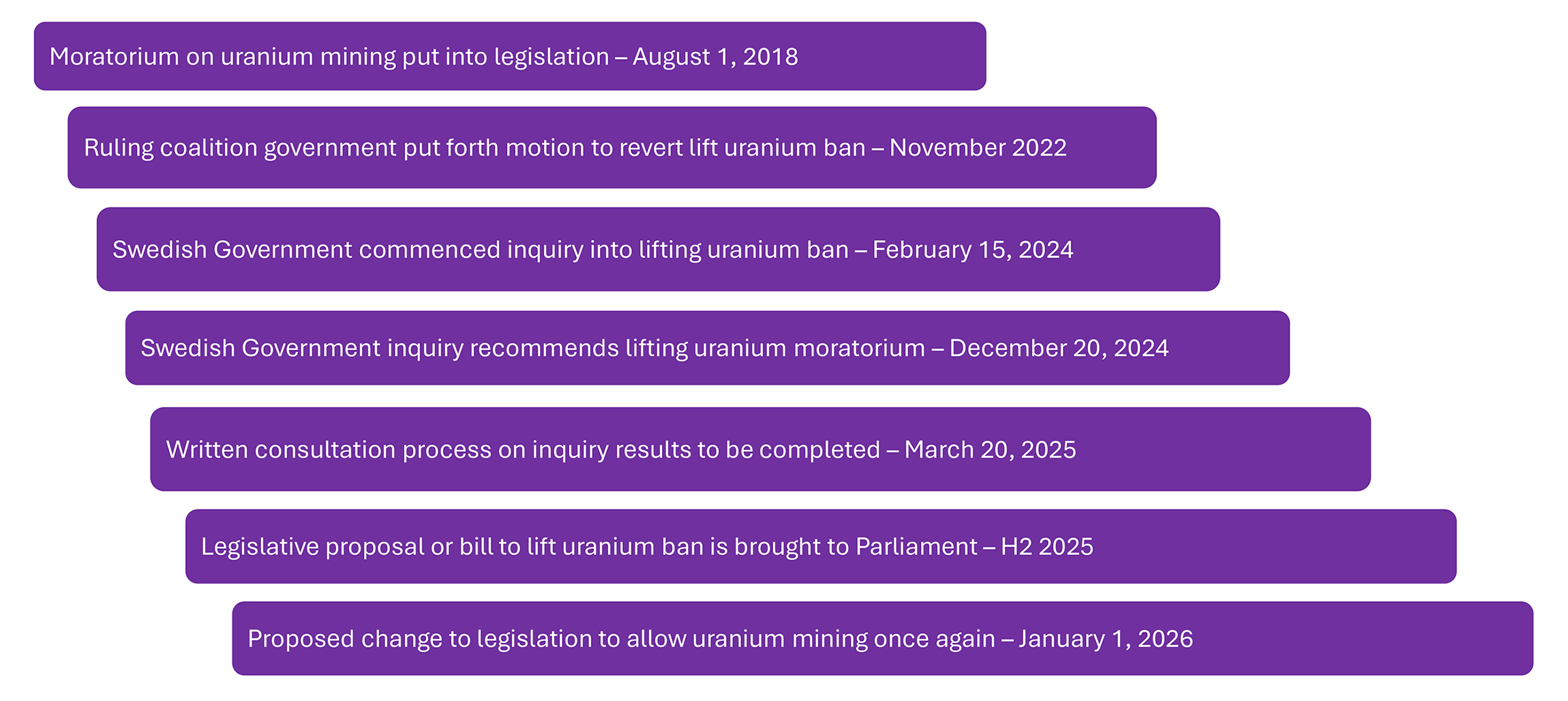
The details of the inquiry and their supporting press release are very positive for District Metals as it is crystal clear that the Swedish Government intends to lift the uranium ban, which makes the risk-reward profile for our Swedish uranium polymetallic properties look much better. Given this proposed timeline to lift the uranium ban we now have confidence in the government’s process to fly some airborne geophysical surveys on our Swedish uranium polymetallic properties. We are still in the planning phase of this proposed exploration work, so expect more detailed news about this in H1 2025.
Can you elaborate on the current step of the lifting process, the ‘written consultation period’? Who is invited to provide comments and what are those comments supposed to be related to?
Yes, the written consultation period began on December 20, 2024 when the inquiry report on lifting the uranium moratorium was released to the public, and it will continue until March 20, 2025. There are at total of 56 referral bodies that comprise companies, associations, parliaments, courts, councils, institutes, authorities, municipalities, counties, etc. that have been invited to provide comments on the inquiry report into lifting the uranium moratorium. District Metals is included on the list of referral bodies.
The Swedish Government wants diverse views on the proposals or material in the inquiry report. Government agencies are obliged to respond to the written consultation. However, an authority decides on its own responsibility whether it has any views to present in a response. If the authority has no comments, it is sufficient for the response to provide information about this.
For other referral bodies, the referral means an invitation to submit comments. It is possible even for those who are not formally invited to submit written opinions to do so.
After the written consultation period, the Swedish Government can choose to convert the inquiry report, possibly with changes given the input that has come during the consultation process, into a legislative proposal and bring it to Parliament. Given the government’s intention to adopt these changes by January 1, 2026, the proposal will likely happen during 2025.
It is encouraging to see a legislative proposal to lift the ban on uranium mining is expected to be added to the parliamentary agenda right after the completion of the written consultation period. May we assume any proposed law change should ideally be supported across the political landscape in Sweden (of course with the exception of the parties that have ideological objections to (uranium) mining and nuclear power)?
The current center-right coalition government and Sweden Democrats appear to have a majority to lift the uranium ban. The opposition include the Social Democrats Party who have been fairly silent on the matter other than to say they are pro-nuclear energy, which is a change from their previous stance to phase out nuclear energy that eventually led to the implementation of the uranium mining ban in 2018. Since the recent and somewhat ongoing energy crisis in Europe it’s clear that the 100% renewables energy policy won’t work, so the Social Democrats appear to have come back to supporting nuclear energy as part of a 100% fossil-free energy policy.
The Green Party in Sweden has been anti-nuclear energy and anti-uranium mining, but the Green Party in Finland is pro-nuclear energy, so perhaps there is hope there.
The next election in Sweden should be in September 2026, and it would make sense that the current center-right coalition government and the opposition Social Democrat Party have reached an agreement to keep a 100% fossil free energy policy that includes nuclear energy and uranium mining to be self-sufficient on the fuel for the nuclear reactors.
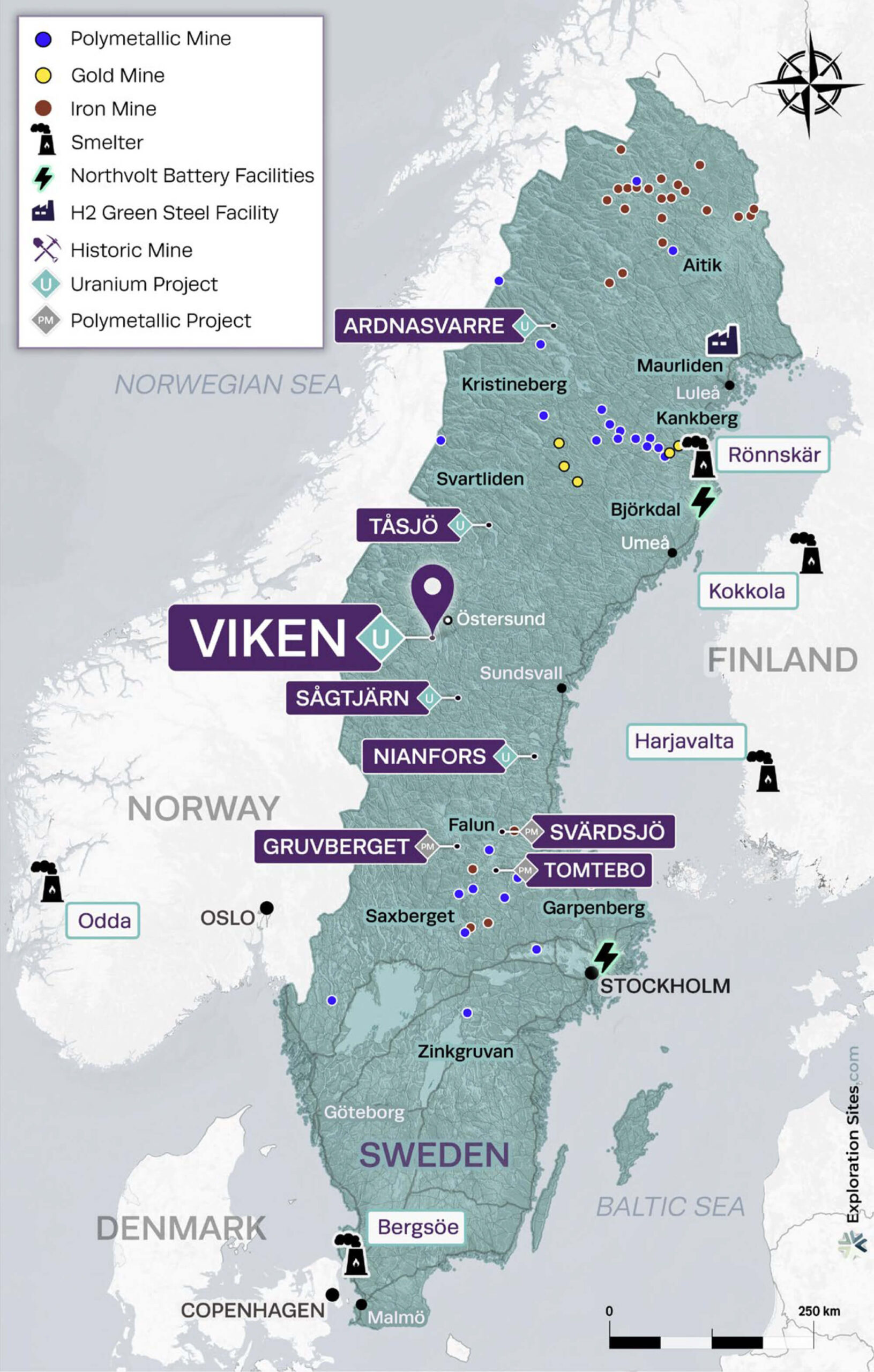
Base Metals in Sweden
The most recent announcement related to the base metal properties in Sweden (in a joint venture with Boliden) was published in October 2024, almost three months ago, and discussed the start of a 2,200 meter core drill program at Stollberg. May we assume the assay results should be out shortly, or should we be a bit more patient?
We typically put out a news release on the visual mineralization from our base metals polymetallic properties such as our Tomtebo or Gruvberget Properties, but the Stollberg Property belongs to Boliden, so we’ve agreed to not report on visual mineralization from Stollberg. I would hope that we’ll have all drill core assays back, interpreted, and disseminated in a news release within Q1 2025.
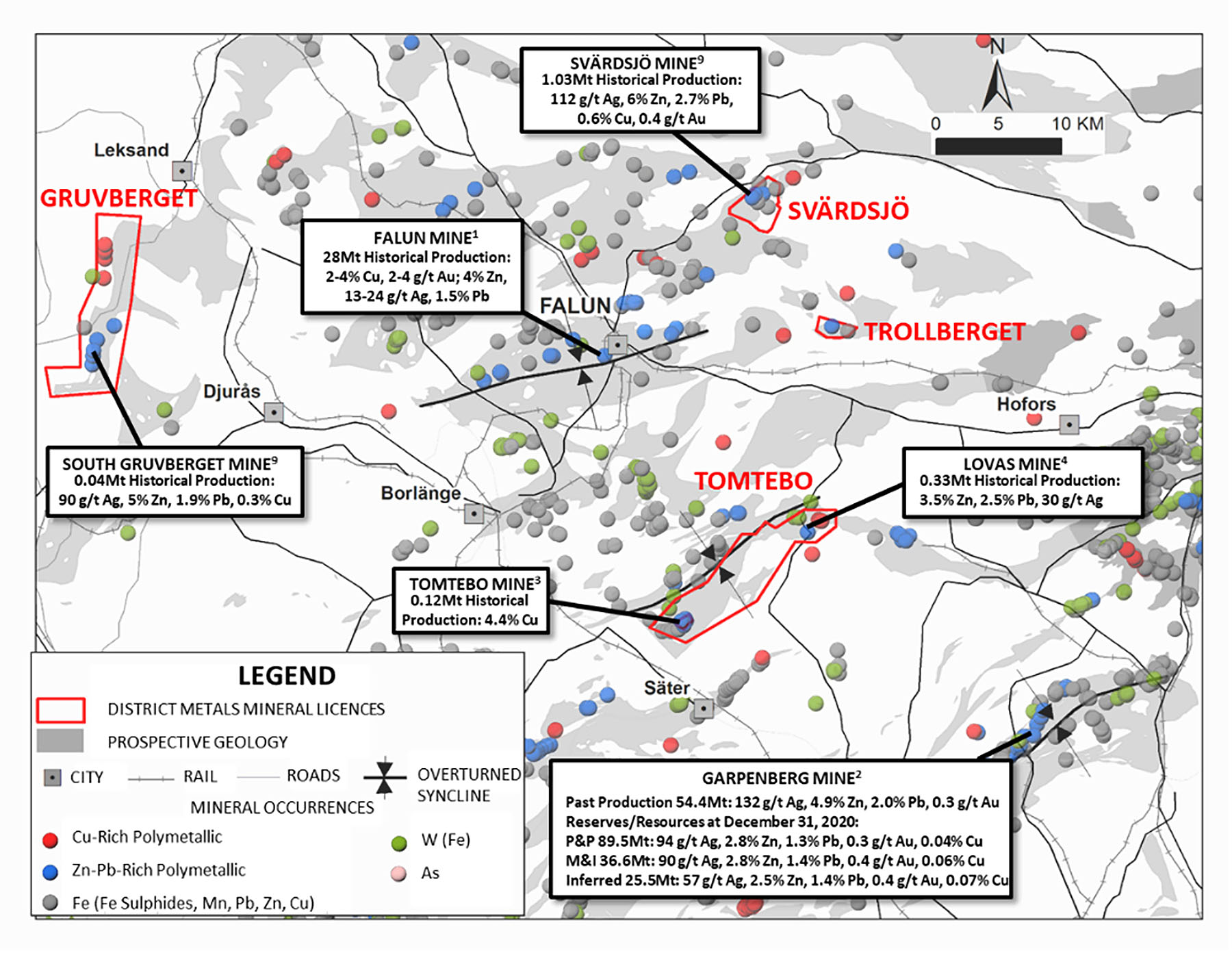
The drill holes will be followed up by a three component downhole electromagnetic survey using Boliden’s proprietary technology. Can you elaborate (of course without revealing corporate secrets) how the in-house technology will help define and refine additional targets at Stollberg?
Sphalerite is a zinc sulphide mineral that dominates the polymetallic (Zn-Pb-Ag-Cu-Au) mineral systems found in the Bergslagen Mining District where the Tomtebo and Stollberg Properties are located. The problem with sphalerite is that it is not conductive, so it makes typical down-hole electromagnetic surveys less effective in locating off-hole conductors that could be indicative of polymetallic mineralized bodies.
Boliden’s in-house, state of the art, down-hole, three component down-hole electromagnetic (DHEM) survey was one of the critical factors behind the discoveries that turned mine closure at Garpenberg into a large expansion project1, so we are very happy to have this technology being used at the Tomtebo and Stollberg Properties.
1 Allen, Rodney L., Jonsson, Rolf H. 2014. Boliden’s Garpenberg Zn-Pb-Ag mine, Sweden – Critical factors behind the discoveries that turned mine closure into a large expansion project. SEG Conference Abstract 0393-000191. https://www.segweb.org/SEG/Events/Conference-Archive/2014/Conference-Proceedings/data/papers/abstracts/0393-000191.pdf?v=010705





Bakar – British Columbia
Are there any plans for Bakar this year?
The EC Target on the Bakar Property looks like a copper porphyry discovery waiting to happen given the VTEM and ZTEM anomalies, geochemical results from outcrop, and structural setting.
Unfortunately, there is an ongoing territorial dispute between the Quatsino First Nations (QFN) and the Tlatlasikwala First Nations, and the QFN is unable to support any new exploration permit approvals until this territorial dispute is resolved.
We’ve been in continuous contact with the QFN, TFN, and BC Government Agencies with no end in sight on this territorial dispute.




Corporate strategy
At the end of the third quarter you still had a very healthy working capital position of in excess of C$5M. Does this mean you could get through this year without ‘having’ to raise cash and that any potential raise would be related to any strength in the share price?
We definitely won’t need to raise any funds this year for our base metals polymetallic projects in Sweden as that will be funded by Boliden in 2025. There is no need for us to do a financing right now, but we are currently in the planning phase for exploration work at our Swedish uranium polymetallic properties, so depending on the size of the proposed budget we might look to finance if the timing is right. Alternatively, if the markets start looking terrible for whatever reason we could just sit tight and not finance at all, so as often, it’s a fluid environment.
How is the listing process in Sweden going and what is the timeline to start trading?
Applicable Canadian securities regulatory authorities are still reviewing our application to obtain exemptive relief, and we have no timing on when that might be completed.
Can you elaborate on the risk for the company’s TSX-V listing in case your request for exemptive relief would be denied?
In 2017 there was a TSX-V Company that obtained exemptive relief to list on the Nasdaq First North Growth Market. Then in 2019 the Nasdaq had some change of rules that are currently being reviewed by the applicable Canadian securities regulatory authorities.
There is no guarantee that we will receive the requested relief and receipt of the exemptive relief remains at the discretion of applicable Canadian securities regulatory authorities.
Do you see any increased levels of corporate interest in the Swedish assets where uranium is part of the element mix? Seeing how the situation develops in Niger, which was a main supplier to France, would likely make some of the European players quite nervous and the desire to develop an European supply chain may be gaining more traction?
Yes, there has been inbound interest regarding our Swedish uranium polymetallic properties, but I would expect that to increase even more once the government’s intention to lift the uranium ban actually materializes as an approved proposal or bill.
Niger supplied 25% of Europe’s uranium, and more recently Kazatomprom has publicly stated that they are finding it more challenging to delivery uranium to the west due to pressure from Russia and China.
The intensifying cold war that we are in makes Swedish uranium very logical for Europe.
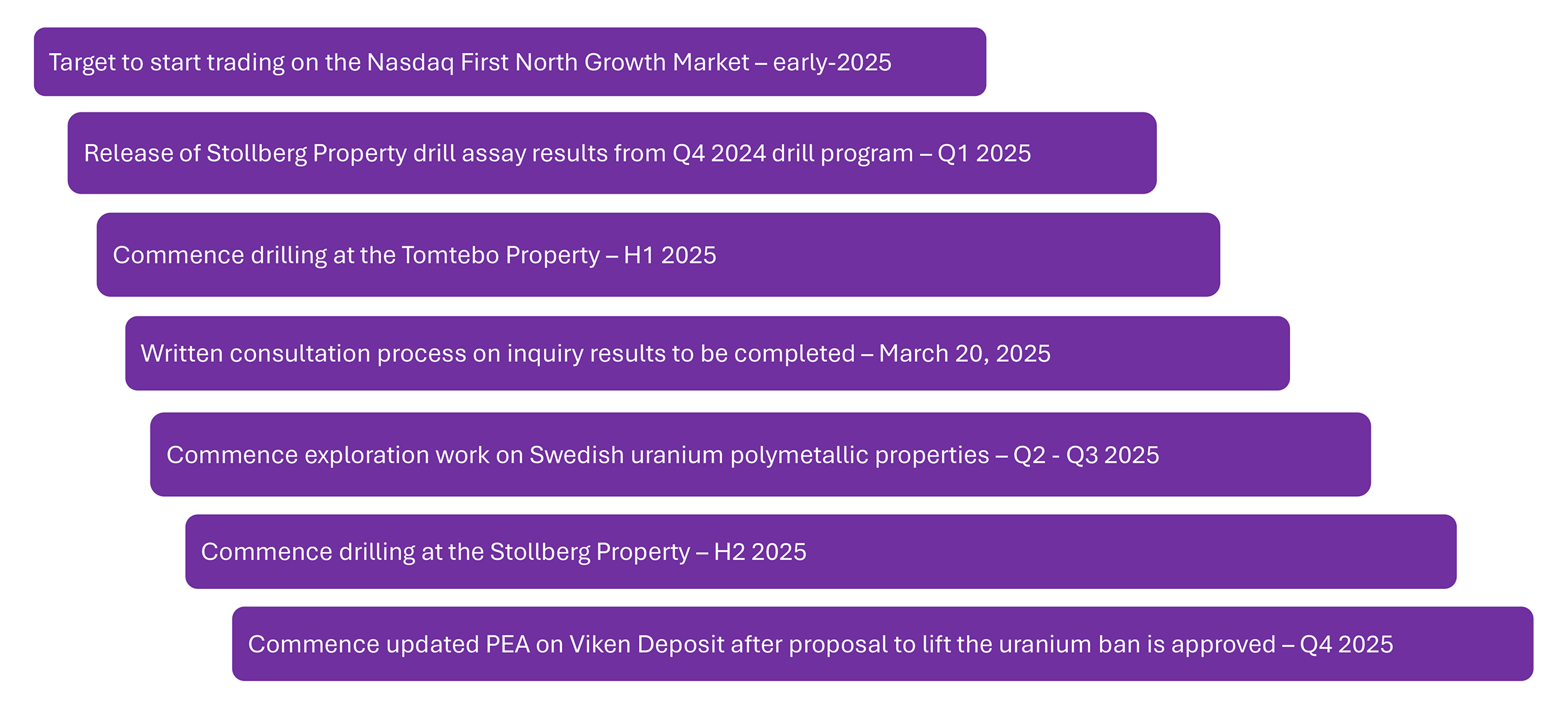
Conclusion
2025 is shaping up to be a pivotal year for District Metals. While the share price has gained a lot of ground since announcing the acquisition of the Viken Deposit, having a clear path forward towards lifting the moratorium on uranium mining will be very helpful as well. As a reminder, when Continental Precious Metals owned the Viken project, its market capitalization exceeded C$300M.
This doesn’t mean that District Metals should be worth C$300M, but it explains how different a project is valued based on whether or not there is a reliable legal framework to move an asset forward. District Metals currently has a market capitalization of approximately C$53M and as the Swedish government advances the proposed lifting of the moratorium, more attention will turn towards uranium projects in Sweden. And while most of our attention goes towards the Viken flagship project as it obviously is the most advanced project in District’s portfolio, the company’s asset base contains several other projects with uranium occurrences.
Disclosure: The author has a long position in District Metals. District Metals is a sponsor of the website. Please read our disclaimer.